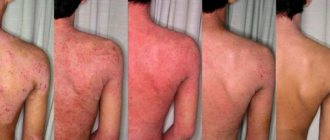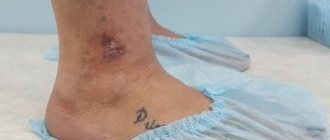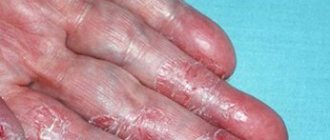Effective treatments for treating dermatitis
Phototherapy
Plasma therapy
NeoGen procedure
Atopic dermatitis (AD) is a chronic allergic disease characterized by itching and redness of the skin. The pathology often has periods of remission and exacerbation, so signs of dermatitis may disappear, and after a while they may reappear. Most often, the disease is diagnosed in childhood and goes into stable remission by about 4–5 years. However, it is not uncommon for the pathology to continue into adulthood.
In common parlance, the disease is often called diathesis. The terms “atopic eczema” or “scabies” are also known, which is incorrect from a dermatological point of view, but to some extent reflects the specific symptoms of the disease. Patients experience chronic itching of the skin, which can be so severe that it causes insomnia. Constant inflammation and peeling of the skin is often complicated by scratches, the occurrence of which is difficult to control. All this has an extremely negative effect on the protective barrier function of the dermis. As a result, the skin “dries out”, that is, the loss of water from deeper layers, which allows allergens to penetrate even further into the body.
Over the past 15 years, the incidence of AD has almost doubled. Among children, the prevalence of this pathology reaches 20%; in adults, the problem occurs in approximately 2–3% of cases. If we talk about statistics for Russia, the prevalence of pathology in childhood and adolescence is about 443 cases per 100 thousand people. It is known that atopic dermatitis develops in 80% of children whose both parents suffered from this disease, and in 50% if one of the parents has the pathology.
Almost half of patients with AD suffer from other allergic diseases. Back in the last century, the connection between atopic dermatitis, bronchial asthma and hay fever was proven. It was designated the term “atopic triad”. In almost 34% of cases there is a combination of atopic dermatitis with bronchial asthma, in 25% with allergic rhinitis, and in 8% with hay fever.
The issue of treating atopic dermatitis in adults is still very pressing, despite the fact that successful steps have been taken in this direction in recent years. The main problem is that therapy requires a comprehensive individual approach and, as a rule, is quite lengthy. However, in almost half of the cases it is possible to relieve AD symptoms and achieve stable remission.
Symptoms
The severity of symptoms of allergic dermatitis in children depends on:
- depending on age - the younger the child, the brighter the symptoms;
- duration of allergenic exposure;
- the current state of the immune system.
As a rule, dermatitis in children of an allergic nature affects the skin of the face, the skin of natural folds, the outer surface of the legs and arms, manifesting itself:
- swelling and hyperemia in places of contact with the irritant;
- burning and itching sensation;
- a rash of small, exudate-filled blisters (opening forms weeping lesions and ulcers);
- peeling of the skin (if you are allergic to certain injectable drugs).
In severe cases (Lyell's syndrome), the following are possible:
- chills and fever;
- headache accompanied by nausea and vomiting;
- dehydration;
- hyperemia of the skin of the groin area, buttock and axillary folds with subsequent formation of blisters and erosions;
- epithelial detachment.
An exacerbation of the disease occurs against the background of stressful situations, severe fatigue, poor nutrition, or prolonged exposure to chemical factors.
What is atopy
The term “atopy” refers to an abnormal reaction of the body to an allergen, which generally explains the nature of the disease.
With the development of atopy, there is an overproduction of IgE antibodies, which are responsible for the appearance of an allergic reaction. AD belongs to the same group of diseases as urticaria, hay fever and bronchial asthma. The pathology is immune-dependent, since the main factor in its development is a mutation in genes. Specifically, we are talking about the genes encoding filaggrin. This structural protein is located in the skin and is involved in the formation of the skin barrier, preventing water loss and the entry of allergens and microorganisms. For this reason, the pathology is inherited from one of the parents, most often from the mother.
Interestingly, atopic dermatitis was essentially known back in ancient times. In those days, this disease was called “idiosyncrasy.” That is, the name reflected the mechanism of development of the pathology - as an increased reaction to an allergen - but did not explain its etiology.
The term “atopy” was first used in 1922 to define the body’s increased sensitivity to external factors.
What complications can there be?
If atopic dermatitis is not properly treated, the disease will develop and lead to complications. Like manifestations, the severity and severity of complications are directly related to the age of the patient. The infantile phase is characterized by complications of atopic dermatitis such as candidiasis and Kaposi's eczema herpetiformis. In childhood, staphylococcal impetigo, molluscum contagiosum and chronic papillomavirus infection are observed. Complications in the adult phase are represented by dermatophytosis and keratomycosis. [10]
Without treatment, atopic dermatitis can significantly reduce the quality of life of the patient and his family. Discomfort is primarily associated with a person’s appearance - with dermatitis, noticeable itchy spots appear on the body, which cause anxiety among others. And although atopic dermatitis cannot be contracted, people are wary of patients and do not want to come into contact with them. Patients experience a continuous desire to scratch the inflammation, so their posture and facial expression look tense and repulsive. Therefore, when it comes to dermatitis, one cannot fail to mention the neurotic and psychological syndromes that this disease entails.
Etiology and pathogenesis
The main role in the pathogenesis of atopic dermatitis is played by hereditary determinism, that is, heredity. It is a number of hereditary mutations in genes that lead to disruption of the skin barrier and defects of the immune system. The patient also has hypersensitivity to allergens, an increased number of inflammatory mediators and a number of pathogenic microorganisms such as Staphylococcus aureus and Malassezia furfur.
The pathological reaction of the body, which provokes atopic dermatitis, occurs as a result of the interaction of three factors:
- skin barrier dysfunction;
- disturbances in the functioning of the immune system;
- influence of environmental factors.
In addition to the factors described, skin barrier dysfunction can be affected by:
- Reduced levels of ceramides (lipids), which protect the skin from aggressive environmental influences.
- An increase in proteolytic enzymes - substances that are responsible for the speed of cell reaction to external stimuli.
- Exposure to proteases from house dust mites or Staphylococcus aureus.
Violation of the protective barrier leads to high skin permeability to allergens and toxins. As a result of their penetration into tissues, a pathological immune response occurs. It comes from Th2 (T helper cell type 2), a special type of cell that enhances the adaptive immune response. They activate B lymphocytes that produce immunoglobulin E (IgE), which results in an allergic reaction.
During an immune response, characteristic itching and rash appear on the skin. Constant scratching stimulates the production of anti-inflammatory cytokines, which in turn cause chronic inflammation. As a result, the epidermis intensively absorbs allergens, which provokes microbial colonization of the skin.
Classification of the disease
When atopic dermatitis develops in children, there are 4 clinical stages of development:
- initial;
- stage of pronounced changes;
- remission;
- clinical recovery.
Depending on the duration of development of the pathological process and clinical and morphological indicators of manifestations on the skin, atopic dermatitis in children is divided into 3 forms according to age:
- infant form - from birth to 3 years;
- children's - from 3 years to 12;
- teenage – 12–18 years.
These forms are capable of restructuring (transitioning from one to another) or going into remission.
According to the severity, the clinical picture of the disease can be mild, moderate and severe.
According to the prevalence of the pathological process, the following are distinguished:
- Limited atopic dermatitis - pathological lesions are located on the body in a certain area, skin damage does not exceed 5% of the entire surface.
- Disseminated (widespread) - the pathological process affects up to 15% of the skin surface, localizing in various areas of the body.
- Diffuse – almost the entire skin surface is affected.
How does the immune system normally work?
The concept of atopic dermatitis reflects the immunological mechanism of pathology development. It is based on the body’s ability to produce an excess amount of antibodies in response to incoming allergens. Antibodies combine with the allergen, which provokes a more pronounced allergic reaction than should be normal.
Let's figure out how the immune system should work normally. It’s worth starting with the fact that the system is represented by several organs (thymus, lymph nodes) and immunocompetent cells. Their main task is to protect the body from foreign elements: viruses, bacteria, fungi and allergens. This is accomplished through the development of protective reactions that are provided by certain cells. That is, the immune system recognizes foreign elements, destroys them and forms immunological memory.
Two types of cells help to perform such functions - B-lymphocytes and T-lymphocytes (killers, suppressors and helpers). Each type of cell has its own role in the operation of the system. Thus, B lymphocytes recognize foreign elements and form memory cells. T-killers are necessary to destroy foreign elements, T-helpers are involved in strengthening the immune response in response to the penetration of pathogenic agents. Suppressor T cells regulate the strength of the immune response by controlling the number of helper and killer cells.
The key to proper functioning of the immune system is a certain ratio of immunocompetent cells. With any quantitative disturbances, the immune reaction becomes pronounced, which is what happens during atopic dermatitis.
To prevent repeated exposure to the pathogen, the immune system forms a memory. It is synthesized by certain antibodies, or immunoglobulins, that form on the surface of B lymphocytes. Antibodies are proteins that have high specificity for antigens. As a result of their connection with antigens, an immune response is triggered in the body.
Several types of antibodies may be present in the body - immunoglobulins A, M, G and E. Each of them has its own function. For example, immunoglobulins A are responsible for protecting the respiratory tract. Immunoglobulins M and G are components of humoral immunity and arise as a result of the penetration of bacteria and viruses. Also, immunoglobulins G appear some time after the disease and can remain in the body for up to several years.
Immunoglobulins E arise as a response to the penetration of allergens. They are the ones who trigger an allergic reaction, which is accompanied by the release of various biological substances (for example, histamine). Under the influence of these substances, a person develops characteristic allergy symptoms: redness, itching, swelling.
Normally, the body contains very little immunoglobulin E, since these cells quickly disintegrate. However, as a result of a genetic mutation, some people have very high levels of these immunoglobulins, which increases the risk of developing atopic dermatitis on the face and body.
When it first encounters a foreign element, the immune system synthesizes certain antibodies. They help protect the body from re-infection for a certain period of time. During an allergic reaction, the process occurs differently. Upon contact with an allergen, a sufficient amount of antibodies is produced, which will subsequently bind to the allergen. Upon repeated contact, an antigen-antibody complex appears. An allergen acts as an antigen. An antibody is a protein produced by the body.
The antigen-antibody complex triggers a whole chain of immunoallergic reactions. With a large amount of immunoglobulin E, a pronounced and prolonged allergy appears. Simultaneously with the allergic reaction, a number of biologically active substances are released. It is these substances that trigger pathological processes that lead to the appearance of typical allergy symptoms. If the amount of immunoglobulins remains high, then the allergic reaction does not disappear, which indicates the development of atopy.
Prevention
To prolong remission after treatment, you must carefully follow your doctor's recommendations on preventive measures. Reducing the factors that lead to increased symptoms helps minimize the likelihood of relapse:
- following a hypoallergenic diet;
- maintaining humidity at least 60%;
- avoiding cold, the room temperature should not fall below 23 degrees;
- removal of all interior items for which it is impossible to apply daily wet cleaning - books, carpets, bedspreads, pillows, curtains;
- changing all wool and feather sleeping items to synthetic ones;
- a thorough inspection of the apartment for mold, removing it (often in the bathroom);
- avoiding the use of powders and strong-smelling products in the home;
- change of clothes to cotton ones;
- exclusion of living in the same apartment with pets;
- use of specialized hygiene products that do not contain dyes and are soft;
- applying moisturizers after showering.
Causes
A genetic mutation by itself cannot provoke the development of AD, since the disease occurs due to a number of provoking factors. These include:
- Atopenes (environmental allergens that provoke the production of allergic antibodies). They can be food (for example, milk, wheat, soy), pollen (wormwood, alder, ragweed), dust (bed mites, animal hair).
- Allergenic foods (spicy foods, alcohol, sweets, smoked foods, etc.).
- Medicines (vitamins, antibiotics, sulfonamides).
- Emotional stress.
- Frequent hypothermia.
In addition, we can identify factors that play a key role in exacerbation of the disease. This:
- Air pollution.
- Harmful working conditions (for example, if during work contamination occurs with solid oil particles or the skin is exposed to aggressive detergents).
- Viral infections (HIV, infectious hepatitis, etc.).
- Diseases of the gastrointestinal tract (pancreatitis, infectious gastritis).
- Pathologies of the endocrine system (thyrotoxicosis, dysmenorrhea, etc.).
Important! It is impossible to become infected with atopic dermatitis from another person. The disease is not transmitted by contact or airborne droplets.






